2001: A Space Odyssey

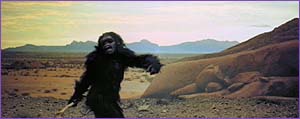
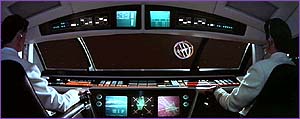
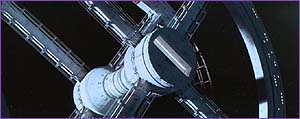
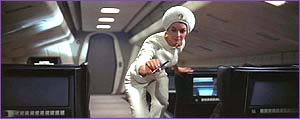
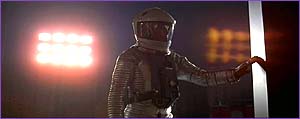
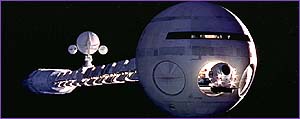
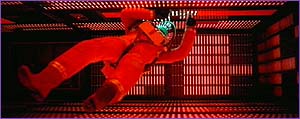
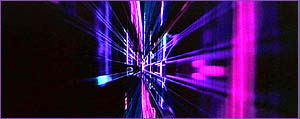
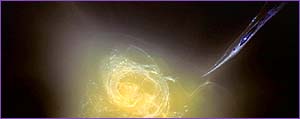
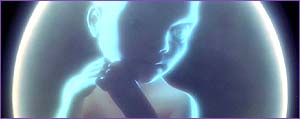
Scenes from 2001.
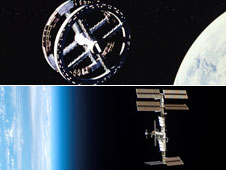
The space station from 2001, top, and the International Space Station. Movie image courtesy A.M.P.A.S.
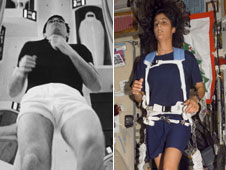
A fictional astronaut jogs on the Jupiter ship Discovery, left. NASA astronaut Suni Williams, right, ran the Boston Marathon in orbit on the International Space Station. Movie image courtesy A.M.P.A.S.
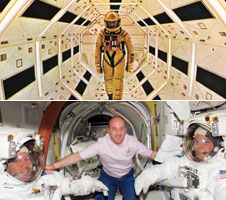
Astronauts suited up for a spacewalk in 2001, top, and on the International Space Station. Movie image courtesy A.M.P.A.S.
2001: A Space Odyssey is an epic science fiction film (1968)1, 2, 3 directed by Stanley Kubrick and based on Arthur C. Clarke's short story, "The Sentinel" (1948).4 In Clarke's tale, a crystal pyramid placed on the Moon long ago by an advanced extraterrestrial race serves to notify its creators when it is finally disturbed by explorers from Earth (see sentinel hypothesis):
[T]hey left a sentinel, one of millions they have scattered throughout the universe, watching over all the worlds with the promise of life. It was a beacon that down the ages has been patiently signaling the fact that no one had discovered it... [W]e found the pyramid and forced it open. Now its signals have ceased, and those whose duty it is will be turning their minds upon Earth.
In the film, the sentinels take the form of enigmatic black monoliths that monitor human evolution, from cave-dwelling stage to space-faring, and also influence and accelerate mankind's development by supplying valuable information at crucial moments. The aliens themselves are never shown and the film ends, in surreal style, with the transformation of astronaut Dave Bowman into a "star child."
There are three main sections to the film. The first depicts prehistoric Earth, where families of man-apes live in fear of predators until an alien monolith appears in their midst. After touching it, they quickly evolve to use primitive tools and weapons, enabling them to gain the upper hand against their prey and adversaries. In one of the most famous scenes in cinematography, an ape tosses a bone into the air where it is replaced by the image of a satellite in space, an editing trick that advances the story millions of years into the future in the span of only a few seconds. In the second section of the movie, astronaut bureaucrats discover another monolith buried on the Moon and when sunlight touches it for the first time in millions of years, it sends a powerful signal to Jupiter. In the final section, humans mount a space mission to Jupiter where another monolith is orbiting. But things go terribly wrong when the spacecraft's computer, known as HAL 9000, goes insane and kills all but one member of the crew. The sole survivor, David Bowman, disconnects HAL and approaches the monolith. He passes through a fantastic light show (during showings many people would apparently take psychedelic drugs and, at this point in the movie, sit in the front rows of the theater). In a bizarre, and for many people highly confusing, final scene, Bowman grows into an old man alone, in the presence of the monolith. Just before his natural death, he is transformed into a baby who, in the final scene, is depicted overlooking the Earth. The sequence symbolized the continuing evolution of humanity into something greater than it is, with alien assistance.
Spacecraft consultants Frederick Ordway and Harry Lange, who had worked for NASA, persuaded companies such as Boeing and IBM to supply prototypes and technical documents for use in the film. Astronauts visiting the set at Borehamwood referred to it as "NASA East."
Clarke produced a novelization of the film5 but located the "Star Gate" near Saturn's moon Iapetus rather than, as in the screen version, in orbit around Jupiter – a serendipitous choice given that Iapetus was subsequently found to have the highest visual contrast of any moon in the solar system, leading to some half-serious suggestions that it might be artificial.6 Although the sequel novels and film, 2010: Odyssey Two7 (1982; film, 1984), 2061: Odyssey Three8 (1988), and 3001: Final Odyssey9 (1997), were less successful, the impact of 2001 itself continues to be felt today.
Cultural impact of 2001
2001: A Space Odyssey initially provoked mixed reactions from film critics and the public. It was highly unusual because it had very little dialogue, instead trying to tell its story through imagery.
Although the movie was not universally praised when it first premiered, it soon came to be widely regarded as a classic by film critics and historians. It was praised for its visual inventiveness, its originality and symbolism, its sound and visual special effects and its musical score. Movies that came after 2001 reflected many of its influences. For instance, Kubrick had originally hired a music composer to write a score for the film and provided him with examples of classical compositions that he thought illustrated the mood he wanted to convey. But ultimately Kubrick discarded the composer's work and used the classical music he had selected instead. Kubrick used Strauss' "Blue Danube Waltz" as background for the docking of a space shuttle with a space station. Not only did recordings of Strauss' music suddenly become very popular, but the music was also used in other films and TV shows, often as a comic or ironic homage to 2001. It was even played on the Apollo 8 mission around the moon. Similarly, Kubrick used the theme from Richard Strauss' "Also Sprach Zarathustra" (Thus Spake Zarathustra) in the opening of the movie to illustrate a dramatic appearance, and the theme was thereafter used for everything from high school graduations to beer commercials.
2001's sound effects had an impact on other films. 2001 was among the first movies to realistically not have sounds in space. (The first of all may have been Destination Moon.) Kubrick was able to symbolize the death of one character by stopping the breathing sounds in his spacesuit. He killed off several other hibernating humans by showing only their computerized monitoring equipment change from the pulses of respiration and breathing to flat lines, "death as a statistic" as one commentator called it. Other movies and TV shows began to use similar techniques, attempting to portray events visually or through sounds that normally would have been portrayed with dialogue. 2001's realistic technological approach to depicting the near-term future of space exploration also had a strong influence on other movies and television shows, often of far lesser quality. Some copied it, whereas others rebelled against Kubrick's vision of the future. The dirty, gritty spaceships of Star Wars (1977) and particularly Alien (1978) were designed in direct contrast to the gleaming white plastic future of 2001, as was the dark, grimy world of Blade Runner (1982). The sentient, murderous HAL 9000 computer has also provoked scientific debates about the development of artificial intelligence.
But perhaps 2001's most profound cultural impact was its effect on how people visualize space exploration. As space historian Howard McCurdy has noted, 2001 established the popular image of what a space station should look like. When Americans are asked to draw a space station, they almost inevitably draw a giant spinning wheel in orbit, undoubtedly based upon their exposure to 2001. Perhaps more subtly, 2001 created expectations in the minds of people that the United States would continue to aggressively pursue space exploration after Apollo and would soon develop giant orbiting space stations and bases on the Moon. When Kubrick made 2001 in the midst of the Apollo program, his advisors did not think that bases on the Moon and missions to Jupiter would be extremely far-fetched 40 years in the future. When the actual year 2001 rolled around, however, various newspaper and magazine articles either lamented that the world had not lived up to their false expectations, or snorted that the movie had "gotten the future wrong." As at least one comic joked, "It's the twenty-first century; how come my car doesn't fly?" Space exploration enthusiasts viewed 2001 as a positive predictor of the future and were disappointed that reality did not live up to their dreams. These false expectations even tended to cloud official planning for space exploration. Yet, as some have noted, the real world of 2001 did have its space stations and space shuttles, but they somehow seemed less exciting than the movie versions.
Many of these people tended to completely misread the movie. Unlike the positive humanistic future of Star Trek, Kubrick's depiction of a gleaming white antiseptic future was actually a dark vision and a warning that technology dehumanized people, turning them into boring drones, or bureaucrats. Various critics noted over the years that the humans in 2001 exhibited few emotions and HAL, the homicidal machine that they built, was in many ways the most human character in the film. Furthermore, Kubrick and Clarke were trying to tell a story, not predict the future. Nobody laments that the world was not destroyed as predicted by various apocalyptic movies such as The Terminator and The Shape of Things to Come. But it is a testament to the power of 2001: A Space Odyssey that people were actually disappointed that the future did not turn out like the movie. [Source: U.S. Centennial of Flight Commission / Dwayne Day]
Then and now
Some aspects of the future envisioned in 2001 have been borne out in today's reality:
Although some of the things in the film are not yet realities, some of them are in the works. For example, although we haven't yet colonized the Moon, NASA has a plan in place to return to the Moon by 2026 and maintain a presence there. Other ventures in space, such as hotels in orbit and routine tourist space travel are being planned by commercial spaceflight companies.
Along with the 40th anniversary of 2001: A Space Odyssey, 2008 also marked the 50th anniversary of NASA. [Text and images for this section came from the NASA web page "1968 Science Fiction is Today's Reality."]
References
1. Agel, Jerome, ed. The Making of Kubrick's 2001. New York: Signet
(1970).
2. Clarke, Arthur C. The Lost Worlds of 2001. Boston: Gregg Press
(1979).
3. Sagan, Carl. The Cosmic Connection: An Extraterrestrial Perspective,
ch. 25. New York: Dell (1975).
4. Clarke, Arthur C. "The Sentinel." In Expedition to Earth. New
York: Harcourt, Brace and World (1970).
5. Clarke, Arthur C. 2001: A Space Odyssey. New York: New American
Library (1968).
6. Goldsmith, Donald, and Owen, Tobias. The Search for Life in the
Universe. Menlo Park, Calif.: Benjamin/Cummings (1980)
7. Clarke, Arthur C. 2010: Odyssey Two. New York: Ballantine (1982).
8. Clarke, Arthur C. 2061: Odyssey Three. New York: Ballantine
(1991).
9. Clarke, Arthur C. 3001: The Final Odyssey. New York: Del Ray
(1997).


